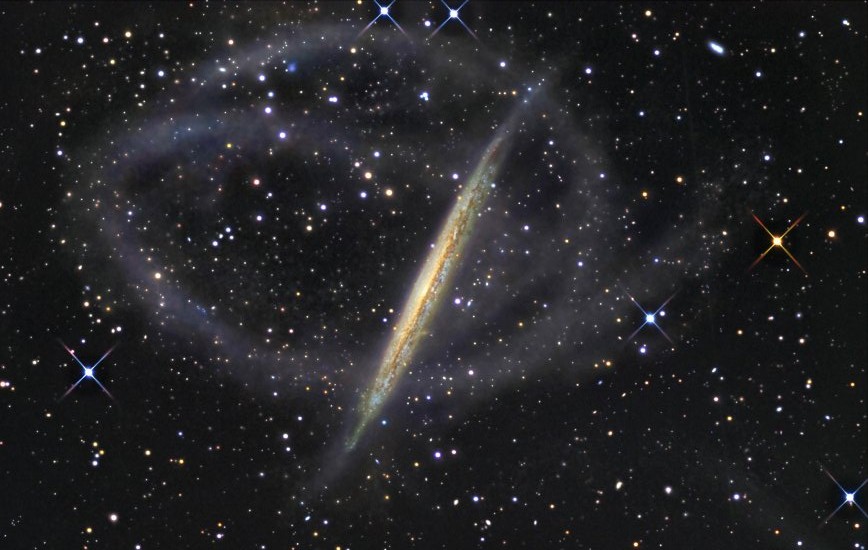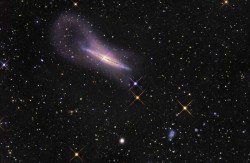The title may sound dramatic, but it is very descriptive. New observations of two galaxies have shown huge streams of stars, not belonging inside those galaxies, reaching out into space. These streams are all that are left of galaxies that are now dead, eaten by their cannibal neighbour, now sitting in their place. The streams form an eerie halo around their killers, looking like ghosts of their former selves…
So what happened to these ill-fated galaxies? Galactic cannibalism is what happened. In both examples, large spiral galaxies have overrun smaller dwarf galaxies, devouring most of their stars. All that is left are the huge fossilized remains in the form of a tenuous distribution of dim, old, metal-poor stars. Judging by the lack of galactic structure in these “ghosts”, the cannibalizing spiral galaxies have been very efficient at eating their smaller dwarf cousins.
The debris surrounding NGC 5907 (approximately 40 million light-years from Earth) extends 150,000 light-years across (pictured top). NGC 5907 destroyed one of its dwarf satellite galaxies at least 4,000 million years ago, consuming the stars, star clusters and dark matter, leaving only a small number of old stars behind to form a complicated criss-cross pattern of galactic fossils.
“Our results provide a fresh insight into this spectacular phenomenon surrounding spiral galaxies and show that haloes contain fossil dwarf galaxies, thus providing us with a unique opportunity to study the final stages in the assembly of galaxies like ours.” – David MartÃnez, from the Instituto de AstrofÃsica de Canarias (IAC) leading the team that carried out these observations.
In the second spiral galaxy, NGC 4013 (50 million light-years from Earth in the constellation of Ursa Major), the ghost of another dead dwarf galaxy stretches 80,000 light-years across and is made up of old stars. Its 3D geometry is unknown, but it has similar characteristics to the Monoceros tidal stream which surrounds the Milky Way. The Monoceros tidal stream is a ring of stars, originating from a local dwarf galaxy that was eaten by our galaxy over 3,000 million years ago.
These images have a huge amount of science to offer researchers. Primarily, the detection of these galactic fossils confirms the predictions of the cold dark matter model of cosmology, which describes how the large spiral galaxies were formed from merging stellar systems.
“…fitting theoretical models to these star streams enables us to reconstruct their history and describe one of the most mysterious and controversial components of galaxies: dark matter.” – Jorge Peñarrubia, theoretical astrophysicist at the University of Victoria (Canada) who is working on this project.
Source: IAC



Thank you Al, muchly appreciated 🙂
Cheers, Ian
April 16, 2008
Another great article. Your articles never fail to captivate me.
Nice work Ian.
Imagine living on a planet in the debris ring of NGC 5907 in the bend in the upper left corner in the picture.
Imagine how the night sky might look with that galaxy “hanging over” you… 😀
Another part of the great mosaic, and beautifully spectacular too. I think the photos are great art as well as good science. Thanks.
To me, this and similar results on scales from planetary to star cluster to galaxian to galaxy cluster (& further to observable universe size) underline astroparticle physicists’ haste in ruling out prosaic nature of dark matter in favour of exotic. By prosaic, I mean baryonic, for want of a better descriptive. One may say, ordinary, instead. So prosaic = baryonic = ordinary in our current state of ignorance.
Imagine, a pound of dark matter, contained with electromagnitic barriers. Then, and probably only then, the general populus will be aware of the reality of this exotic mass, I must admit a bit of that same feeling.
Really nice work by these researchers. Congratulations!
Thanks! Very interestingly!
Those 2 amazing images were taken and processed by the one and only R. Jay GaBany. I find it mysterious that his name isn’t mentioned anywhere in this article. His tidal stream version of NGC 4013 was on APOD a couple of months ago.
He also has an older version of NGC 5907 which shows an arc@ http://www.cosmotography.com/images/small_ngc5907.html
We can see original space objects within 150 million kilometer. Ahade of it everything is mere image into space mirror. It can not explain in short. . Therefore it invites to visit http://www.spacemirrormystery.com to know the original truth